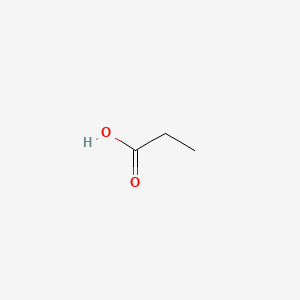| MeSH term | MeSH ID | Detail |
|---|---|---|
| Acidosis | D000138 | 13 associated lipids |
| Abscess | D000038 | 13 associated lipids |
propionic acid
propionic acid is a lipid of Fatty Acyls (FA) class. Propionic acid is associated with abnormalities such as Epilepsy, Infection, Tuberculosis, Alkalosis and Ischemia. The involved functions are known as Uptake, Biosynthetic Pathways, Methylation, Protein Overexpression and Biochemical Pathway. Propionic acid often locates in Body tissue, Cytoplasmic matrix, Membrane, Protoplasm and Extracellular. The associated genes with propionic acid are TRIO gene, TRRAP gene, SLC5A8 gene, SLC33A1 gene and Homologous Gene. The related lipids are Fatty Acids, Propionate, butyrate, Valerates and mycocerosic acid.
Cross Reference
Introduction
To understand associated biological information of propionic acid, we collected biological information of abnormalities, associated pathways, cellular/molecular locations, biological functions, related genes/proteins, lipids and common seen animal/experimental models with organized paragraphs from literatures.
What diseases are associated with propionic acid?
propionic acid is suspected in Propionic acidemia, Ischemia, Infection, Ulcerative Colitis, Alkalosis, Methylmalonic acidemia and other diseases in descending order of the highest number of associated sentences.
Related references are mostly published in these journals:
| Disease | Cross reference | Weighted score | Related literature |
|---|
Possible diseases from mapped MeSH terms on references
We collected disease MeSH terms mapped to the references associated with propionic acid
PubChem Associated disorders and diseases
What pathways are associated with propionic acid
There are no associated biomedical information in the current reference collection.
PubChem Biomolecular Interactions and Pathways
Link to PubChem Biomolecular Interactions and PathwaysWhat cellular locations are associated with propionic acid?
Visualization in cellular structure
Associated locations are in red color. Not associated locations are in black.
Related references are published most in these journals:
| Location | Cross reference | Weighted score | Related literatures |
|---|
What functions are associated with propionic acid?
Related references are published most in these journals:
| Function | Cross reference | Weighted score | Related literatures |
|---|
What lipids are associated with propionic acid?
Related references are published most in these journals:
| Lipid concept | Cross reference | Weighted score | Related literatures |
|---|
What genes are associated with propionic acid?
Related references are published most in these journals:
| Gene | Cross reference | Weighted score | Related literatures |
|---|
What common seen animal models are associated with propionic acid?
There are no associated biomedical information in the current reference collection.
NCBI Entrez Crosslinks
All references with propionic acid
Download all related citations| Authors | Title | Published | Journal | PubMed Link |
|---|---|---|---|---|
| Lü Z and Lu Y | Methanocella conradii sp. nov., a thermophilic, obligate hydrogenotrophic methanogen, isolated from Chinese rice field soil. | 2012 | PLoS ONE | pmid:22530002 |
| Fujioka K et al. | Objective display and discrimination of floral odors from Amorphophallus titanum, bloomed on different dates and at different locations, using an electronic nose. | 2012 | Sensors (Basel) | pmid:22438757 |
| Relling AE et al. | Effects of glucose, propionate and splanchnic hormones on neuropeptide mRNA concentrations in the ovine hypothalamus. | 2012 | J Anim Physiol Anim Nutr (Berl) | pmid:21732994 |
| Dwidar M et al. | The future of butyric acid in industry. | 2012 | ScientificWorldJournal | pmid:22593687 |
| Lichtor PA and Miller SJ | Combinatorial evolution of site- and enantioselective catalysts for polyene epoxidation. | 2012 | Nat Chem | pmid:23174978 |
| Poonam SD et al. | Multifaceted attributes of dairy propionibacteria: a review. | 2012 | World J. Microbiol. Biotechnol. | pmid:22806746 |
| Hub JS et al. | Organic molecules on the surface of water droplets--an energetic perspective. | 2012 | Phys Chem Chem Phys | pmid:22674063 |
| Jagadeesan G et al. | Ethyl 7-oxo-3,5-diphenyl-1,4-diazepane-2-carboxyl-ate. | 2012 | Acta Crystallogr Sect E Struct Rep Online | pmid:22590391 |
| Fonseca BD et al. | Structure-activity analysis of niclosamide reveals potential role for cytoplasmic pH in control of mammalian target of rapamycin complex 1 (mTORC1) signaling. | 2012 | J. Biol. Chem. | pmid:22474287 |
| Raju CS et al. | NIR monitoring of ammonia in anaerobic digesters using a diffuse reflectance probe. | 2012 | Sensors (Basel) | pmid:22438767 |
| Chien CC et al. | Effects of different substrate composition on biosynthesis of polyhydroxybutyrate-co-hydroxyvalerate by recombinant Escherichia coli. | 2012 | Appl. Biochem. Biotechnol. | pmid:22203393 |
| Oshima S et al. | Efficacy of organic acids, bacteriocins, and the lactoperoxidase system in inhibiting the growth of Cronobacter spp. in rehydrated infant formula. | 2012 | J. Food Prot. | pmid:23043820 |
| Baldwin DS and Mitchell A | Impact of sulfate pollution on anaerobic biogeochemical cycles in a wetland sediment. | 2012 | Water Res. | pmid:22204939 |
| McGinty D et al. | Fragrance material review on benzyl acetate. | 2012 | Food Chem. Toxicol. | pmid:22387848 |
| Khorasani S and Fernandes MA | 2-(2-Carb-oxy-eth-yl)-1,3-dioxoisoindoline-5,6-dicarb-oxy-lic acid methanol monosolvate. | 2012 | Acta Crystallogr Sect E Struct Rep Online | pmid:22259409 |
| Liang ZX et al. | Enhanced propionic acid production from Jerusalem artichoke hydrolysate by immobilized Propionibacterium acidipropionici in a fibrous-bed bioreactor. | 2012 | Bioprocess Biosyst Eng | pmid:22228298 |
| Wu SC et al. | Correlation between bio-hydrogen production and polyhydroxybutyrate (PHB) synthesis by Rhodopseudomonas palustris WP3-5. | 2012 | Bioresour. Technol. | pmid:22342035 |
| Tran QM et al. | Out of plane distortions of the heme b of Escherichia coli succinate dehydrogenase. | 2012 | PLoS ONE | pmid:22393428 |
| Król E et al. | Effects of combined dietary chromium(III) propionate complex and thiamine supplementation on insulin sensitivity, blood biochemical indices, and mineral levels in high-fructose-fed rats. | 2012 | Biol Trace Elem Res | pmid:23065486 |
| Bernhard BC et al. | Chromium supplementation alters both glucose and lipid metabolism in feedlot cattle during the receiving period. | 2012 | J. Anim. Sci. | pmid:23048144 |
